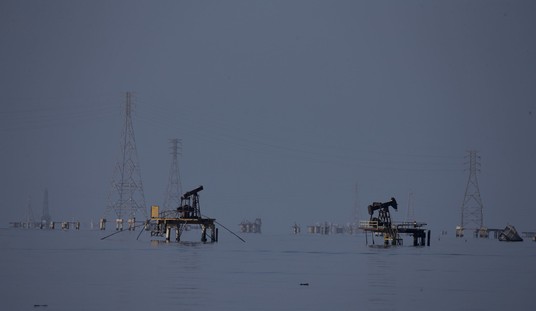The Obama Administration has filed some 27,000 pages of documents in Federal court which disclose the process by which it decided to forge ahead with a deepwater drilling moratorium in the Gulf of Mexico, in spite of expert advice, public opinion and a Federal judge’s ruling.
The documents also show that the Administration stonewalled a U.S. Senator’s request for information, a point apparently lost on the mainstream press. They show that the bureaucracy contemplated a de facto moratorium: since the bureaucracy has the power of the permit, who needs a moratorium? And they also show that ignorance (willful or otherwise) caused them to grossly misrepresent the economic impact of the moratorium to the court.
As reported by the Wall Street Journal, the Administration forged ahead with plans to stop all drilling in water depths over 500 feet until November 30, even though its own estimates showed the ban would cost some 23,000 jobs.
[The documents] show the new top regulator or offshore oil exploration, Michael Bromwich, told Interior Secretary Ken Salazar that a six-month deepwater-drilling halt would result in “lost direct employment” affecting approximately 9,450 workers and “lost jobs from indirect and induced effects” affecting about 13,797 more. The July 10 memo cited an analysis by Mr. Bromwich’s agency that assumed direct employment on affected rigs would “resume normally once the rigs resume operations.” [emphasis added]
Hmm. July 10. That’s very interesting, because on July 28, Sen. Mary Landrieu (D-LA), chair of the Senate Small Business Committee, included the following remarks in her opening statement at the Committee’s hearing on the spill’s impact on business:
I note for the Record that on July 21, 2010, I invited Dr. Christina Romer, Chair of the President’s Council of Economic Advisers to testify before this committee to provide the Administration’s perspective and its own economic analysis in support of the moratorium. Unfortunately, the Administration was unwilling to provide a witness for today’s hearing. Yesterday, I spoke to Dr. Romer personally and she indicated the Administration does not currently have the economic impact data, which is very disappointing to learn. It is my understanding that such a review has been initiated, however, which is encouraging.
Sen. Landrieu had received no data on economic impact as of July 28, nearly three weeks after Mr. Bromwich’s memo to Sec. Salazar, which contained the figures the Senator was searching for.
There’s also no basis for the Agency’s assumption that employment levels will return to pre-moratorium levels any time in the foreseeable future. These deepwater rigs are mobile; given the choice between $0 per day to sit idle in the Gulf or whether to pursue overseas contracts for $500,000, which would you choose? And they will not move without a four to five year work commitment. Once the big rigs leave, they’re gone for good.
Then there’s the case of the Non-Moratorium Moratorium, the near-total cessation of shallow water drilling permits, despite the President’s and the Secretary’s insistence that the deepwater moratorium is the only one currently in place.
In another document, William Hauser, chief of the regulations and standards branch of what was formerly called the Minerals Management Service, outlined the risks of various drilling activities in an email to colleagues and then wrote: “The more I write this stuff the more I believe we can/should/could regulate/stop activities through a prudent management process versus a moratoria scheme.”
He added, “I guess the moratoria approach is necessary because the MMS cannot be trusted to regulate.”
Here’s the third whopper:
The administration has said in court filings that the economic effect of suspended drilling wasn’t as severe as the industry asserted. In a filing with federal court in eastern Louisiana June 23, the day after a judge overturned the initial six-month halt, Justice Department attorneys said it affected 33 deepwater wells, “less than 1% of the existing structures in the Gulf dedicated to oil exploration and production.”
I’ve heard this blather before, out of the mouth of Rep. Ed Markey (D-MA). So the twisted thinking goes, “What’s 33 rigs, out of 3,800 platforms in the Gulf?”
It’s shocking that we entrust regulation to people with so little knowledge and so little interest in the things they regulate.
Yes, rigs and platforms are both “offshore structures”, in the sense that jetliners and bicycles are both “modes of transportation”. They have grossly different jobs.
“Rigs” drill wells. That’s the activity where money is spent in big chunks, so lots of jobs are dependent on rigs. One big deepwater rig accounts for 1,200 or so jobs, between direct labor, transportation and shore-based support. That’s before you factor in the impact of all those salaries on the local merchants and governments.
“Platforms” are structures for accessing producing wells. Some hold a dozen or more wells and contain processing equipment, but there are many, many platforms in the shallow Gulf that only support a single well.
Rigs are the economic driver that make the industry work, that makes the oil-based economies of the Gulf States work.
Throughout this extended nightmare, I’ve wondered whether we have a) an Administration that’s truly naive and ignorant of the impact of their policies on our region, or b) an Administration that fully intends for their actions to kill domestic jobs, irreparably damaging an industry and a region.
Their own evidence now points to b).
Cross-posted to VladEnBlog.













Join the conversation as a VIP Member